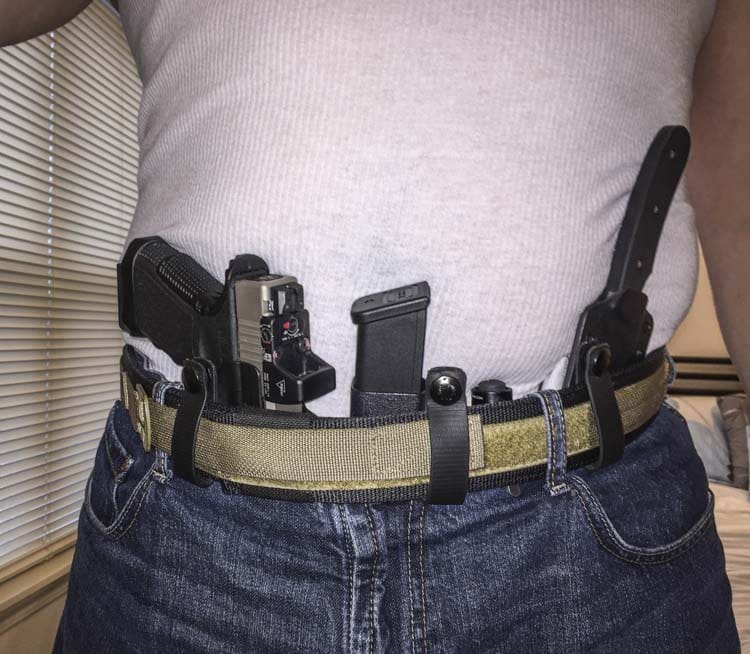
By Chris B.
As I write this I am seated comfortably in a coffee shop taking a break from the work I should be doing this Sunday afternoon and thinking about my EDC and a recent article written by TTAG’s Nick Leghorn. After reading the article and various comments, I get the feeling that a lot of people might be dismissing something that really works for me: red dots on pistols. The concept has truly helped me get back to where I once was as a shooter. In addition, I have found the system to be reliable and compact enough to make it part of my everyday carry . . .
If I were to take my glasses off right now, I could not read the Word document I’m typing. But even if your eyes aren’t that bad, each year you spend on Earth will take some of the crispness out of your sight picture. Two years ago, as a result of my coming to grips with this conundrum, I decided to take the financial and logistical plunge of putting a Trijicon dual illuminated RMR on my carry pistol, a Gen 3 GLOCK 35.
I ended up really loving the end result and carried it in the appendix position with a Seraphim Holster from Dale Frike. I ran it though a few classes. I ran the gun in the rain, in the mud, and in snow. I never had any issues with reliability, the sight, or finding the dot under pressure. I did, however, have a few issues with the G35 being a long-ass gun and chambered in .40 cal.
My issues with it being a long gun related to the fact that carrying it around all day in the appendix position meant it stuck into my groin in an uncomfortable manner from time to time. My issue with .40 caliber was that I was sacrificing ammo capacity for a round that ultimately wasn’t offering me much more than a 9mm in practical downrange ballistics.
So wanting a shorter gun and not wanting to go lower than a 15-round magazine, I switched to a GLOCK 19. I was sold on the RMR by that point, so I put on on a One Source Tactical slide and carry it in a Raven Concealment Eidolon holster. I haven’t looked back.

My PHLSTR IWB GLOCK Mag carrier worked just fine transitioning from a Glock 22/35 mag to the Glock 19/17 magazines I was carrying as a reload. Add my Surefire Backup Light, and a Spyderco fixed blade called the Reverse, and you have my EDC.
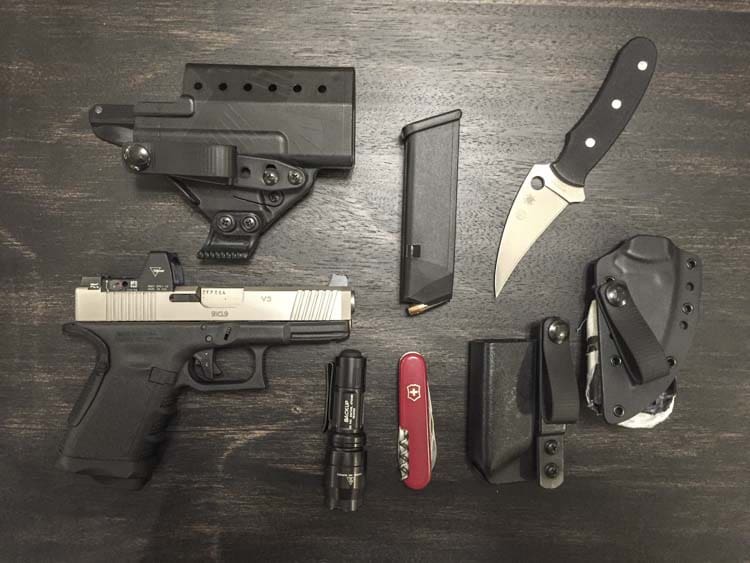
It all carries on my belt line with a Volund Gearworks Atlas G-Hook belt. With a variety of untucked shirts or sweatshirts depending on the weather, I can conceal it pretty much anywhere, anytime. In addition to all the stuff on my belt, I still carry a small non-threatening pocket knife to do menial things and not scare the timid souls in my area.
I can clean Ken Hackathon’s Wizard Drill without issue. I can consistently make headshots out to 25 yards off hand. This isn’t to brag. I know plenty of shooters who use iron sights who can eat my lunch any day of the week on the range. It’s just that I have objectively looked at my old times and my current times with irons vs. red dot and found that I have lost nothing up close and gained precision and accuracy at distance under the same time constraints. I feel a large part of that has to do with being able to see the dot better than I can see the sights.
So when I read Nick’s article, I took pause and thought a little bit about what he said. What he says makes perfect sense. After reading the article and watching the video posted with it, I thought about what I carry and how I carry and how that might have made my transition to red dots a lot easier than I realized.
First off, my gun is set up with the slide milled out and irons that allow me to co-witness. The RMR is positioned toward the rear of the slide. When I draw I find the front sight during my draw process, and as I go through the process of aligning my sights I pick up the dot as the front sight begins to align with the rear sight. As that happens I just switch to the dot and drive on. So long as the pistol is at full presentation, I don’t have any issues. If I pull back to a compressed or low ready, I just repeat the process of picking up my front sight again as I push out and hand off again as the pistol gets close to full extension.
Gabe has a video that explains it. I know a lot of people here at TTAG may not appreciate all of his views on firearms and personal defense. That said, he’s been working with and writing about red dots on pistols for longer than most. And he’s not the only one. Steve Fischer of Sentinel Concepts says something very similar.

My pistol is set up to help me out. The KE Arms GLOCK that Nick was shooting has an Aimpoint tube forward mounted. This might make it little harder to use the front sight hand off technique I was described above. The tube of the Aimpoint may obstruct picking up the front sight as the tube is forward mounted and appears from what I can tell to block the sight until you are looking through the tube. In addition, an RMR and an Aimpoint T1 don’t weigh the same. Slide mounting one vs. the other does not mean you’ll get similar reliability. Also forward mounting an optic may create a different set of reliability issues altogether. It is hard to tell. But all this combined might have accounted for some of the reliability issues Nick was facing in addition to having trouble picking up the sight.
Aside from pistol setup, I was watching Nick draw. I watched him over and over actually. Admitting that I’m only watching one iteration and that I could be completely wrong, I think I see a fundamental difference in between how Nick draws and how I draw. It comes down to where the front sight is in relation to the rear sight as we begin to level the pistol out while driving the gun to target.
My front sight is above my rear sight when I start to push out. Nick’s seems to start out below it (Look at the six second mark of the video to see what I mean). I have cut and pasted a diagram below with my limited paint shop capabilities to illustrate this point.
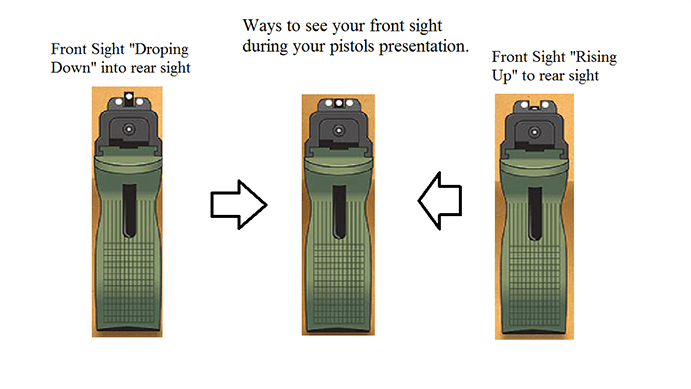
Essentially, when I draw I end up orienting the muzzle up at the beginning of the process of pushing the pistol out to the target. I did not realize I was doing it until I was at a class with the aforementioned Pat McNamara. When coaching some of the students on ways to improve their draw, he mentioned that he found orienting the pistol slightly muzzle up during the press out allowed him to better acquire the front sight and have a faster hit. If you watch this clip from Pat’s Panteo DVD you can see what it looks like. His draw stroke is in the 37th second [NSFW language].
After he said it, I realized I had been doing that already for some time. When I tried doing it the other way, I realized that I was chasing my front sight once I got onto the target. Thinking back to when I started drawing from a holster, I realized I had had this problem early on. Eventually, through trial and error I got faster at picking up the front sight. However it was not until I switched how I carried the pistol that my presentation improved drastically. After the fact I realized that by changing from strong side to appendix carry, I changed the way I drew the pistol and in essence was changing the way I oriented my sights during the push out.
For an excellent discussion of how all this works, I will refer you to the late Todd Louis Green’s amazing website, pistol-training.com. http://pistol-training.com/archives/9323 If you watch the video from Todd, who also carried appendix, you’ll see in a slightly more exaggerated fashion how the muzzle and thus the front sight is oriented slightly up allowing the shooter to lower it down “into” the rear sight. If you watch the Range Time video (for those of you who don’t like Range Time over the whole Stolen Valor thing, I get it, but the video illustrates a point) with Travis Haley and Ron Avery, you can see that they do it differently. Todd’s article points out the differences between the two methods in an articulate and thoughtful manner. For my part, I am not saying one is right and the other is wrong.
Instead, I have come to realize that by chance when I transitioned to a red dot on my pistol, I had already inadvertently changed my draw stroke by changing to appendix carry. Mechanically with appendix carry, it just seems to work out that when you support hand comes up to meet the pistol your muzzle is going to be slightly up as opposed to slightly down. This allowed me to drop my front sight into the rear sight. While this seems like a minute detail, I think it has some significant implications when trying to run a red dot on your pistol. For one thing if you have properly sighted in the optic, the dot will follow the muzzle. The optic housing is in many ways like windshield of your car: when you look out you can only see what is above the hood. In this case, the dot is being projected wherever the muzzle is oriented. If it’s below the line of sight or “below the hood” you will not find it quickly. If however it is above the line of sight you will be able to pick it up almost without trying. I’ve included some pictures to illustrate this.

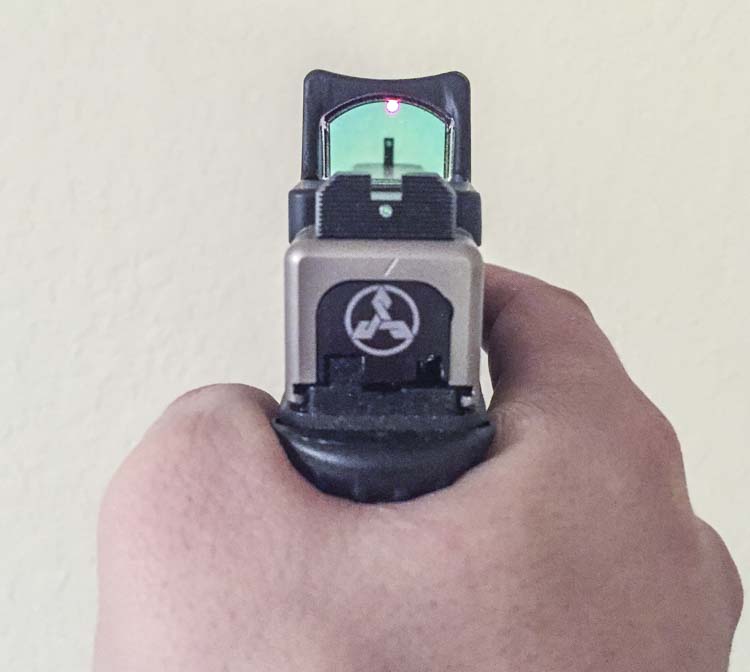
When I try drawing my red dot from a strong side holster, I feel like there is a slight delay. I think that is because strong side draw does not immediately lend itself (at least for me) to muzzle up orientation during the press out. Looking back at some of the proponents of red dots on pistols, it seems like some of the most vocal are also strong advocates for appendix carry. After thinking more about red dots on pistols this does not surprise me. Looking at Nick’s draw, I think I can see he is slightly more muzzle down than level or up when his pistol is coming to his line of sight (check the 6 second mark). As a result, he may be having a harder time than necessary when it comes to dot acquisition.
So with all that rambling on my part, I think that there are a lot of good reasons that people may have been less than satisfied with their first attempts at slide mounted red dots on pistols. I think there is a learning curve, but I do not think it is as steep as some people would think. I do think there is a need to look at one’s draw stroke or presentation from the ready position. In addition there is a need to look at the pistol you have on hand with said red dot and look for visual index points you can acquire as you are pushing the pistol out to help you pick up the dot quickly.
I know red dots on carry/ non-competition pistols aren’t for everyone. The tech is still being developed for one thing. The positioning of the dot on the slide is still being worked out. The best choice of optic is still in debate. As a result, putting a red dot on your pistol isn’t for the financially challenged. I acknowledge that in many ways it is a luxury item. It was a good expenditure for me, but an RMR costs about as much as a GLOCK 19. Also, depending on how you present the pistol, it may not work as well for you as it does for others. All that said, if you’re willing to spend the coin and assess your draw stroke and presentation, you may find it to be well worth your time and money. I have.



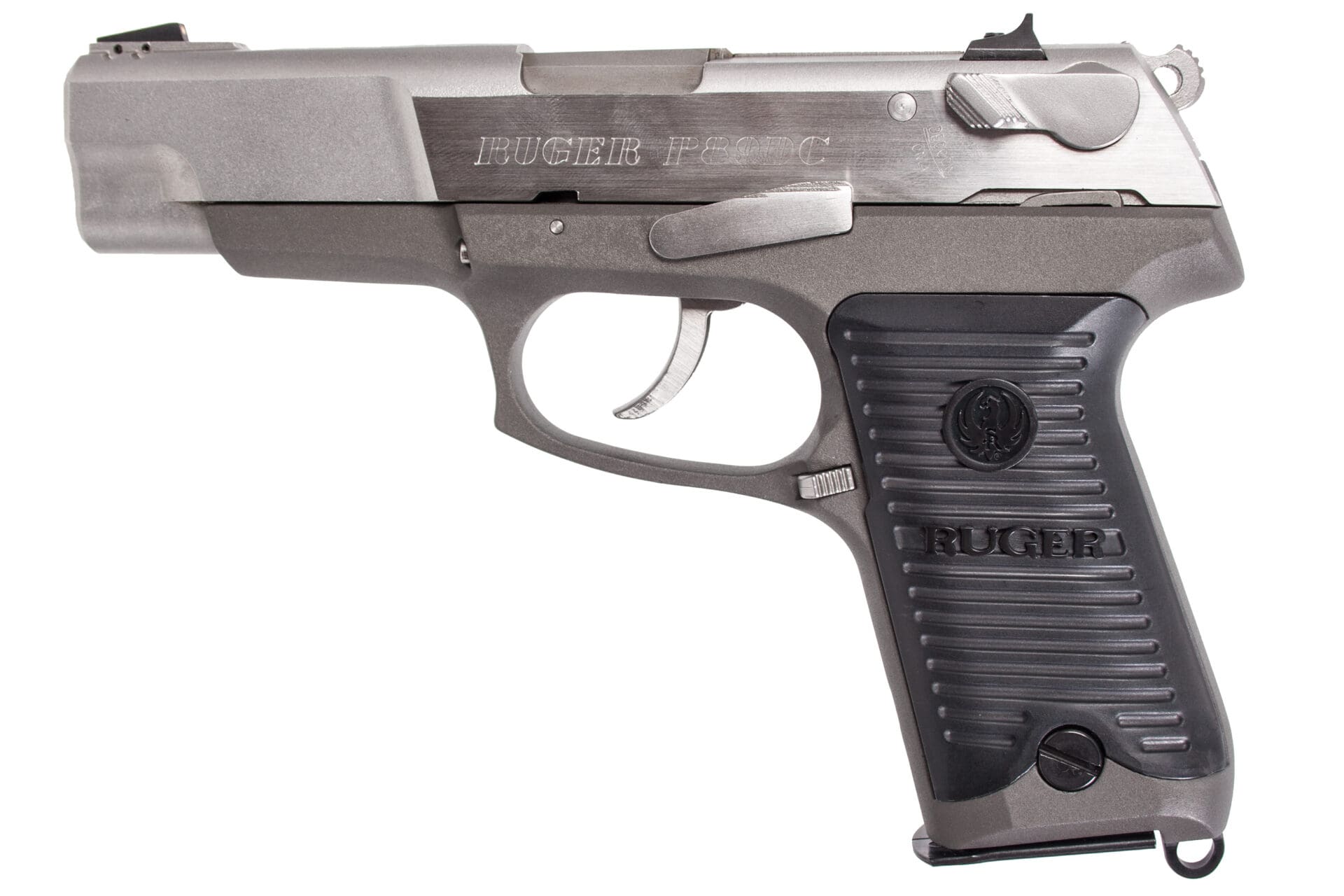
critical self evaluation. the ultimate journey for anyone on any topic. thank you for your experiences.
Fantastic article! I have a RDS M&P 9 w/ BUIS and a stock(ish) M&P 9 with irons that I’ve been trying to get to the range so I can put them on a timer back to back. I think I’m probably going to the come to the same conclusion you did.
I will say that finding the front sight first as you’ve described helped me quite a bit with my presentation and consistency. It works for either irons only or RDS but becomes critical if you’re running an optic.
Again, great article. Thanks for contributing.
Great post! As my eyes have also lost the ability focus without glasses I decided a while back to red dot my FN 5.7. Your article adds insights on eliminating the slight red dot hunt I’d experienced. Thanks!
The Eidolon is easily the best appendix rig on the market in terms of concealability. If Raven would add something like the mag caddy that G-code has for the incog, it would be even better. The mounting holes are all pretty much the same so you can add the mag caddy to the eidolon. Highly recommend it.
Not sure if it’s related, but back when I first started shooting Straight Eight sights, it took about 1 night outing to start presenting muzzle up. Seeing just one dot and not instinctively knowing whether it is front or rear (I know, it’s pretty obvious….), drums that one home pretty conclusively. The Glock’s grip angle really aids in this as well. Bringing up XDs, and particularly Sigs, I have to be much more cognizant of keeping the muzzle up.
I remember my 10M pistol coach’s voice, as he pointed out the damaged ceiling tiles at the indoor range, saying to always raise the pistol to the target, never lower the pistol to the target.
I’ve also been to clubs where letting a muzzle rise above the horizon will get you a stern rebuke from the RSO.
It would be hard for me to not present a pistol the way Nick does.
I think you’re grossly overestimating the amount of angle on presentation the author was talking about, if you are at risk of damaging ceiling tiles on draw or presentation I’d flag you too. The pistol stays pointed downrange, with just enough angle to keep the front sight visible over the rears…. the author’s illustration is pretty spot on.
The asshats that put pellets in the ceiling were lowering their muzzles from very high, yes. The holes closest to the shooting stations were at 45 degrees or more.
But I’ve been at outdoor ranges where 5 degrees would get the RSO’s attention.
Are we talking about presenting just a couple feet above the target here, or something more like 5 degrees?
I’m talking about the difference in your bullets hitting above the X in the 9 or 8 ring at ten yards. It’s slight but it can make a difference in how you pick up your sights.
Yup should still be able to hit the target during presentation, like Chris said maybe a high Charlie or something like that, not feet over the target. And definitely not 45 degrees!
The pic of your strapped on loadout, nicely demonstrates how one good way to prevent the contours of a gun, or anything else, from printing; is to stuff so many things around it, that there is really no discernible outline of anything……
Props on appendix carrying a 35. That’s up there with Dirty Harry appendix carrying his magnum.
One thing to consider, is to swap the spare 17 mag for a 19, or carry an additional 19 if you can fit it. Mainly in order to be able to quickly and without much ado get your gun back to fully loaded carry condition, after an incident.
You’re right on the money for dropping the front sight into the rear notch on presentation. I’ve carried an RMR-equipped 17 for years and it’s the only way to find the dot especially under stress.
I’ve found this to be faster for iron-sighted pistols as well, not just in carry but competition. Follow that front sight all the way out on presentation.
Carrying that loadout in that position I don’t see how you can be sitting comfortably. Then, I’m a FWG.
Great article.
Man, oh man, there is lot of stuff going on with that gun!
Good write up.
Great article. I have carried a red dot for a few years and concur that slight muzzle up presentation markedly helps with finding the dot. It also helps with open sights. I first tried it after watching the Late Paul Gomez on video with a slightly muzzle up ready position, rather than a muzzle down position. After trying it, I found I was faster on sights muzzle up.
Great write up Chris!
As I need to wear cheaters to read, I’m also finding value in a RDS for carry.
How do you sit down with all that in the front?
So jeans or pants with a low ride such as Wrangler Jeans U cut or Duluth Trading Co’s “ball room” line of jeans and pants make a big difference. Also the belt makes a huge difference. A stiff and sturdy belt without a traditional buckle makes a big difference.
“As I write this I am seated comfortably in a coffee shop…”
Looking at that picture, in going to go ahead and call bullshit on the “seated comfortably” part. Its ok., I’ve been there dude, trying to carry to much shit, a full size 1911 plus some gadgets, and telling yourself something like, “fuck yeah, if Batman can do it so can I.” You look like you can walk around with a coat on and have good concelability and a solid draw, but if you want us to believe you sit comfortably with that load out on the front of your belt then you should explain that shit. Like how do you not jab your guts out sitting down? Do you move stuff around first? Take stuff off? Honestly i’d like to know, because I like appendix carry while walking and for the quick draw, but I’m slimmer than you and have a svelter load out and in not sitting comfortably anywhere while my gun is up front like that.
“Comfortable” is subjective.
I don’t wear a watch, jewery, or wedding band because I find it uncomfortable. Yet, I can walk around with two guns, spare mag, two knives, flashlight, and multitool comfortably.
It’s all how you perceive it.
Interestingly enough, I find the idea that appendix carry is only for skinny people to be wrong. First off for inside the waist band carry in general not just appendix carry can quite uncomfortable for people with low body fat content. I had quite a few buddies with six packs that hated 4 oclock position carry because it hurt their hip. Specific to appendix carry, people who are quite thin may be at more risk of having hot spots from where the muzzle end of the holster digs in. Also people who are very thin may not have the upper body circumference to allow for appropriate draping of the shirt. In other words if your chest is the same size as your abdomen even as a thin fellow you will not get much concealment. While I have some abdominal fluff, my chest is big enough that with a guayabera shirt in the spring/summer or a flannel shirt in the fall/winter that I can indeed conceal what I was wearing. I should have included a picture of that, but this was not a “how I conceal my stuff” article as much as a my thoughts on red dots on pistols article. As noted above appropriate fitting pants and the right belt go a long way. When I sit down and I do not have enough ball room, appendix carry sucks. When I sit down and the pistol is jutting into my belly it sucks. The balance is having a belt stiff enough with pants with enough room for your groin to allow you to keep the belt almost at the level of my naval. So essentially when I sit down all I do is pull my pants up enough to make it work and then sit down. In addition, I have found for my body type, I use the single point attachment for my pull dot loop on the holster, as opposed to the two attachment system. This allows the pistol to pivot on its own. So when I sit it cants the butt of the pistol laterally. The Eidolon has a bumper and claw, which actually help it go back to position when I stand up. Sure there is sometimes readjustment, but I had to readjust my pants with 4 oclock carry too. Also as far as printing, the pistol prints very little because I carry it so low in the belt line. In fact if I am dressed an a way that I am worried there may be more printing, I cut down to the pistol and the light and leave it at that. The down side of the pistol being so low is it can hinder the draw, but I have found that if I do a slight crunch, kinda like Todd Green in the video I create enough space to get a full grip on the pistol prior to the draw. The magazine carrier has a single attachment point and can move and cant freely. I tried the Incog with the magazine carrier attached and it was very uncomfortable for me. Also carrying the G17 mag keeps the mag plate of the magazine higher on my belly which is amazingly enough more comfortable than carrying the g 19 magazine. Finally with the knife, if you look carefully at the picture, you can see I have attached a foam backer to the sheath which helps press the knife handle into my body and decrease printing. In actuality the knife probably prints more than anything, but it does it in a fashion that doesn’t stand out. It doesn’t look like a gun so I do not worry about it as much. Maybe I should more, but at some point you just role with it. And speaking of rolling with it. Minus the knife, I have been able to use this set up in hands on force on force drills, kinda like the one’s Craig Douglas does with Shiv Works (youtube it) and it worked just fine. While this has been long, I can see how a discussion of how appendix carry worked for me might be a nice follow up article. All that said, I don’t really care how anyone carries, just so long as they do it, and it takes a lot of trial and error to figure out what works so that you will actually carry a gun every day and everywhere you are legally able to do so.
“interestingly enough, I find the idea that appendix carry is only for skinny people to be wrong.”
Appendix carry is better for people with flat stomachs. A person can be what is known as “skinny fat” and still have issues with appendix. I’ve only ever met people with reasonably low body fat percentages who will carry appendix comfortably.
Being really skinny (bony) is a problem, as well. And the way you dress plays a big role, too. If your belly hangs over your belt, it will angle the pistol in a way which digs it into your stomach when seated.
It’s not for everyone; I love it and won’t go back.
He left out the part about virtual comfort in a virtual coffee shop.
Thanks for a great post! Including the pics is icing on the cake! I hope to see more from you.
nananananananananana….. Batman!! Darn good write-up, though.
Th authors analysis of the front sight being slightly elevated would explain a lot, and makes sense, as when you recover from recoil, the front sights are coming down to the rears.
Excellent post. Lot to digest. and a heck of a rig there. I wish I didn’t have a gut and could appendix carry a 19. It’s really the best way to conceal such a beast. and there are no compromises, like with my little single stack. I am glad that I was taught early on about pushing out with my front sight high, it makes all the difference to me in getting a quick sight pic, red dot or no
Very good article. A few things stand out. 1 MRDS on pistols are not for everyone. I completely agree. Along those lines, different people will find different setups to be preferable. 2 They probably take practice otherwise hunting for the dot will occur and hunting takes time. Time is of the essence in self defense or even, as I think Nick pointed out, competition. Regarding hunting for the dot, I think it would be worse in nonstandard situations (weak hand only, weak hand dominant, odd stances).
With that position of carry, isn’t your muzzle covering Big Jim and the twins?
Not something I am willing to destroy.
Don’t shoot your dingy.
Sorry, but I cannot take seriously the opinions of someone who absolutely refuses to accept less than 15 rounds in his pistol, yet claims to be a good shooter.
No gadgets, no matter how fancy, can ever make up for the ‘spray and pray’ mindset. IMO, OFC.
Hi Kenneth. At no point did I say anything about absolutely refusing to accept anything less than 15 rounds. I said “not wanting to go lower than a 15-round magazine.” The whole point about spending essentially the cost of another Glock 19 on an RMR to put on my Glock 19 is so that I can better see where my sight is, in this case a red dot. The dot is easier for my eyes to see. Thus I do not have to spray and pray. I just have to look for my dot. 10 years ago, I did not need this, but now, its kinda of nice to have. Wanting 15 rounds in a pistol is not an odd thing either. Kenneth, have you ever shot at someone? Have you ever been shot at while trying to shoot at someone? Its tricky, the target (the dude with the gun) tends to move. And sometimes you tend to move also. Or so I am told. In addition, the human body can absorb a lot of bullets and not die instantly or even be incapacitated instantly. So while all your rounds may hit the target, which may be moving, and may be making you move, they may not actually hit anywhere that makes him stop doing what he is doing. People do not have convenient “shoot me here” signs on them. Or so I am told. They also do not square off perfectly and stand up strait presenting the maximum amount of vital target area possible either. So you may be aiming at your best guess area at the time hoping something vital sits behind it. Of course all this is hypothetical. I have never seen a guy take 4 rounds of 45 ACP all in the chest and abdomen and not die immediately or even stop charging the guy who was shooting at him. I have never seen a dude take 4 rounds point blank of 40 cal and not die at all or even stop holding the knife he was holding. And I have never seen someone who got shot 6 times with some cheap ass 32 ACP while holding his arms up in front of him covering his face and torso only to be discharged home from the ED with 6 bullets in his arms that never penetrated deep enough to do any critical damage even though the shooter appeared to display pretty good accuracy all things considered. Also never in the history of civilian armed encounters has anyone ever had to deal with more than one attacker. That has never happened and it never will. So please go on not taking anyone seriously who thinks that having more than 5,6, 7 or even 14 rounds is a good idea. I think the drafters of the New York SAFE Act would appreciate your opinion and agree with your assessment.
Comments are closed.